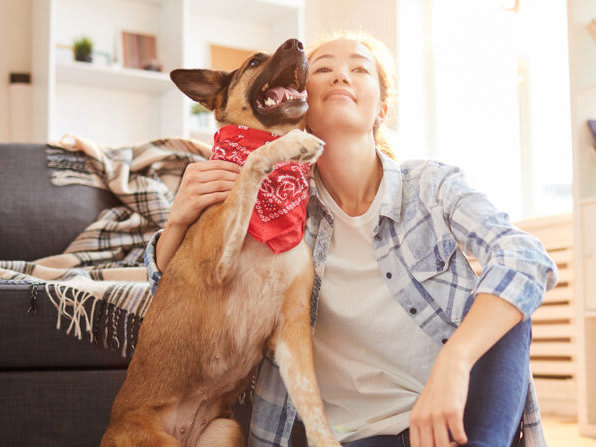Sometimes your dog just wants to be heard. Barking is a natural means of communication for dogs, but it can be disruptive if left unchecked. If you want to stop your dog barking, the first step is to figure out why they’re barking in the first place. Here are the top 5 reasons why your dog might be barking and how to encourage them to stop this behavior.
1. Barking to sound the alarm
This is one of the most common reasons for barking. Most owners can probably relate to this scenario: Everything is quiet in the house and your dog is perfectly calm. Suddenly, a visitor rings the doorbell. Now everything’s at a Code Red. You spend the next minute or so trying to quiet your dog down while your guest waits to be greeted.
One solution for this type of barking is to remove the trigger. If the mailman walks by and no one is around to see him, will your pup make a sound?
If your dog is suspicious of any outside pedestrians they see from the window, close the curtains or blinds. You can also block their access to the window with plants or furniture they can’t get on top of.
As for barking at neighbors on the other side of the fence when they’re in the backyard, bring your dog back inside as soon as they start barking. Don’t leave them out in the yard unsupervised all day.
Special note: When you’re trying to redirect your dog’s attention, stay calm and don’t raise your voice. If you yell at them while they’re barking, they’ll interpret it as you joining them and they’ll only get more excited.
How to stop the barking:
Professional trainer Sue Sternberg recommends building a “quiet sequence” for your dog so you can get them to stop barking on command. It’s hard to train your dog to stop doing something (in this case, barking). A quiet sequence gets them to do something else instead of barking. Here’s what it looks like:
- If your dog starts barking, interrupt them by clapping twice sharply
- Call your dog away from the trigger (Get as close as you need to get them to listen)
- Have them run through a routine of commands such as “Lie, down, stay”
- Once your dog finishes the commands and stays quiet, give them a treat
It’s hard to shift your dog’s attention away from a trigger once they’ve started barking. Practice your quiet sequence multiple times in a distraction-free zone first so they’ll be able to recall it easier after they start barking.
2. Separation anxiety barking
Separation anxiety, or leaving your dog alone, is a common reason for barking. If you spend a lot of time with your dog and then suddenly you’re gone for lengthy periods of time, they may not know what to do with themselves when left alone. We’ve spoken about how to curb separation anxiety before, but here are a few extra tips.
How to stop the barking:
Getting your dog to stop barking when they’re left home alone is all about preparation. The best thing you can do for your pup is to get them used to being alone. Start small by stepping into another room without your dog or standing outside your front door for a few minutes. From there you can leave them at home while you go out for a walk around the block or run some quick errands. Spend a few weeks giving your dog plenty of opportunities for some “me time.”
Once your dog has a baseline comfort with being home alone, you can help them out in a few other ways:
- Tire your dog out before you leave with a walk in the morning (aim for 30 minutes)
- Give them a high-value treat right before you leave like frozen peanut butter or a puzzle toy
- Look into dog walkers for midday breaks
3. Barking out of fear
Just like how we scream or yelp when something startles us, dogs will let out a howl when they’re scared. Barking tells whatever’s scaring your dog to stay away if they know what’s good for them.
How to stop the barking:
Use desensitization through socialization to calm your dog down around other people and dogs. If there’s a specific sight that gets your dog riled up, like a person on a skateboard, ask a friend to fill in for the role and expose your dog to them slowly.
Start off with your friend far enough away that your dog won’t start barking but can still see them. Give them a treat to let them know that this person isn’t so bad. Move your dog closer to the person and reward them as long as they stay quiet. Practice this over a course of weeks to get your dog used to whatever bothers them.
If your dog is especially fearful of something, you should consult a professional trainer to work through the behavior.
4. Barking to get your attention
It’s good to know your dog loves you, but barking to get your attention doesn’t stay cute for long (especially if you’re trying to get some work done).
How to stop the barking:
It’s simple: ignore the unwanted behavior. This could be a real test of patience depending on how tenacious your pup is. Stay strong, though. If you spend an hour ignoring your dog and finally cave because you can’t take the noise anymore, you’re telling your dog they can get what they want if they’re loud enough.
As soon as your dog is quiet, give them verbal praise and a treat. Each time they quiet down, wait a few seconds longer before rewarding them.
5. Barking while they’re playing
If your dog meets up with some friends at the park and they get in a good game of chase, they may want everyone to know they’re having a good time by barking. When you play a game with your friends, do you play in silence or do you chat with each other? The same idea goes for dogs.
How to stop the barking:
Don’t try to stop this one! Let your dog have fun and talk with their friends. That being said, keep an ear out for low growls or barks that are aggressive in nature as well as your dog’s body language. If your dog looks and sounds like they’re warning other dogs to stay away, get their attention and remove them from the situation.













